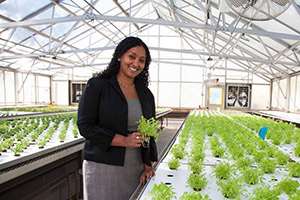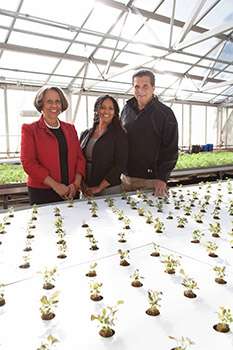Researcher examines how neighborhood food environments impact diet-related illnesses

The seeds for Hanaa Hamdi's remarkable plans to change the food environment in Newark were planted during her own childhood.
"I grew up in southeast San Diego, a section of the city that was notorious for crime, drugs and violence. This community was economically and socially segregated," recalls this assistant professor in the Department of Family Medicine. "My family came to America from Ethiopia as political refugees. My dad had briefly served as a diplomat to the U.S. and from my conversations with him about America, I remember imagining the streets to be paved with gold."
What her family found was anything but. On their first night in the Dream Street Apartments a drive-by shooting sent a bullet that barely missed her baby sister's crib. Her parents were up all night. "My brother and I could hear my mother weeping and pleading with my dad. We didn't understand what was being discussed but sensed it was serious. Although I never said so to my parents, I secretly hoped we would go back to Egypt, back to Europe, to the Middle East, anywhere in the world would've been better than where we had landed."
But there was no going back and the next day, they began to adjust to their new life in urban America. "The transition was not easy, but we toiled hard to make it work. My father's first job was as a janitor, and then he worked as a postman. Later he would become a welder. My mother took public transportation to go to work and to school. We were enrolled in the local public schools. We learned to chart safe walking routes to school and to dress in neutral colors to avoid gang affiliation. We made new friends."
Southeast San Diego was afflicted with social ills. "Poverty and economic and residential segregation lead to gang activities, violence such as drive-by shootings, selling of drugs in our neighborhoods," says Hamdi. The nearest supermarket was two and a half miles away and Hamdi remembers taking the bus and carrying home big gallon jugs of milk. Other factors made for an uneasy transition. "It wasn't just the issue of having to travel far to fetch our groceries, it was also the lack of healthy food. As a kid, I didn't mind it at all. I loved potato chips and Twinkies, but that was a great concern for my parents. My dad would always say, 'There isn't any healthy food here.' And so many of the kids and adults were overweight."

In spite of the negative issues, there were positive community attributes that created safe spaces and protected the neighborhood children. "Neighbors, mostly low-income families, took turns watching over each other's children. While the neighborhood lacked material wealth, it had cultural richness; my community was made of African-American, Mexican, Filipino, Cambodian, and Vietnamese people." For Hamdi, southeast San Diego is a lot like Newark. "Every American city has problems, but I focus on the positive attributes. I want my work in Newark to build on resources, not deficits."
Hamdi is the principal investigator of the Healthy Living Initiative and the director of community-based research and evaluation at New Jersey Medical School. She earned her undergraduate degrees in biomedical sciences, with a minor in mathematics and romance languages and community health education. In 2012, she added a joint Ph.D. degree from Rutgers University, the University of Medicine and Dentistry of New Jersey, and New Jersey Institute of Technology in urban systems. As a systems scientist, Hamdi's work examines the structural, social, and cultural factors that impact health inequalities. More specifically, she studies neighborhood food environments and their impact on diet-related illnesses, such as diabetes and obesity.
Last summer, her Healthy Living Initiative, a study that addresses behavioral and social barriers to healthy lifestyle, successfully completed its first phase, Healthy Living Families, a randomized obesity prevention study with 52 families in Newark's South Ward. The study provided combinations of weekly fresh produce and 10- to 15-minute health, nutrition and family-tailored exercise activities for parents and their preschool-age children, for four months. Successful results have led to funding for successive phases of the study, Healthy Living Schools, which began in November 2013.
The successful initiative has to be linked to the enormous effort Hamdi invested in the community. For her doctoral degree she studied the local food environment in the South Ward. "We evaluated 91 grocery stories and bodegas and 75 restaurants, held focus groups, did interviews, and hired and trained 26 community residents in all aspects of the research," she says. "I always try to engage the community in every project. Without that, you can't make any lasting change. More important, we can learn a lot from the community residents." In fact, it was the seniors being interviewed who recommended that she start her interventions with young children to change entire families.
Hamdi's behavioral interventions are showing promising results but she knows that long-term changes can only take place when the environment also changes. She is working hard to make this happen. This past summer, Hamdi received funding from the New Jersey Department of Health to implement the second phase of Healthy Living Initiative, called Safety-by-Design, a research-guided evaluation of six large parks and two community gardens in Newark. Hamdi is also tackling issues of crime, unemployment and even zoning. For example, she is exploring crime prevention in city parks through environmental design—better lighting and more open entryways. "We are creating joint agreements with community groups, schools, firefighters, and the police department, not just to do surveillance but to participate in the space. The more people use the space, the more crime goes down."
In addition, Hamdi is collaborating with New Jersey Sen. Ronald Rice on two food environment related policies that address food price tagging and fluctuation. During her dissertation research, Hamdi found that less than 10 percent of food items evaluated in the corner stores had actual marked price tags. More disturbingly, food prices fluctuated up to 40 percent at the beginning of each month, when public assistance vouchers (SNAP and WIC) were received. Hamdi explains, "When food prices are not marked, store owners can change the prices without accountability. Price gouging is particularly problematic now among families who are already financially vulnerable."
Her days are long but stimulating. Working with a group of medical students recently who were interacting with children in the community, Hamdi was asked by a 4-year-old boy, "What kind of doctor are you? Do you give shots?" She replied, "No, we're the kind of doctors who provide fresh fruits and vegetables, so we can help little kids like you become healthy," to which he replied, "I want to be that kind of doctor when I grow up."

















